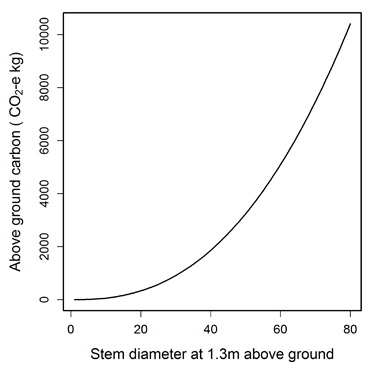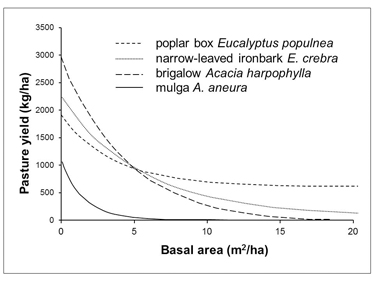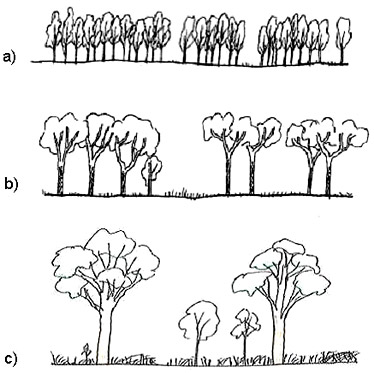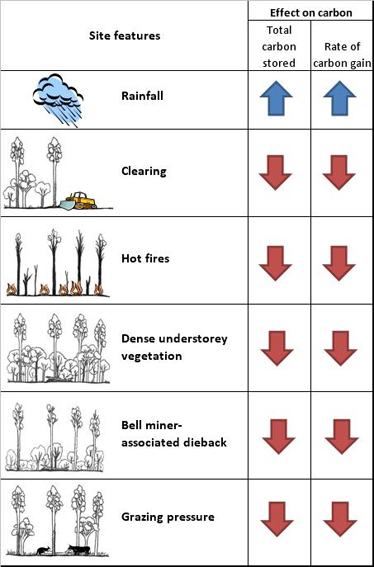Farming carbon

Potential to store carbon
- The above-ground parts of woody plants in mature wet sclerophyll forest in Queensland can hold between 370 and 1800 tonnes of carbon dioxide equivalent per hectare.
- Above-ground carbon in wet sclerophyll forest is stored in living trees and shrubs, dead standing trees, fallen timber and litter.
- Regrowing wet sclerophyll forest will capture atmospheric carbon and store it in woody plant tissues. The peak carbon accumulation rate is likely to be between 6 and 30 tonnes of carbon dioxide equivalents per hectare per year.
Carbon farming might not always mean bringing wet sclerophyll forest back to its full carbon capacity as soon as possible. Some carbon returns might be traded off against other land-uses, such as selective timber harvesting and livestock grazing, which may limit carbon accumulation rates. Selective timber harvesting and low to moderate levels of livestock grazing appear to be compatible with reforestation in wet sclerophyll forest.
Note: to generate carbon credits you will need to register a project with the Clean Energy Regulator using an approved method. The methods detail the conditions or rules for generating carbon credits (Australian Carbon Credit Units) and how vegetation is to be managed as part of a project.
Carbon storage and tree size
Large trees hold far more carbon than small trees because the amount of carbon held increases exponentially as the trunk diameter of a tree increases (see graph). For example, the carbon held in an average very large tree (e.g. 60cm trunk diameter) is about the same as that held in 480 smaller trees (e.g. 5cm trunk diameters).

See Wet sclerophyll forest Management Guideline for details.
Tree dbh (cm) | Dry matter (kg) | Carbon (kg) | CO2 equivalent (kg) |
|---|---|---|---|
5 | 5.3 | 2.5 | 9.7 |
30 | 458 | 215 | 790 |
60 | 2565 | 1206 | 4424 |
Trade-offs between trees and pasture
Increasing the basal area (the area occupied by the cross-section of tree trunks and stems at their base) of trees tends to result in decreased pasture yield.
This has been observed for a variety of vegetation types in Queensland, and is likely to also apply to wet sclerophyll forest.
It should be possible to combine carbon farming of regrowth with livestock production, but landholders should consider how increased tree growth may impact on their pasture yield.
Grow big trees to maximise carbon

See Wet sclerophyll forest Management Guideline for details.
A few big trees can hold far more carbon than a large number of small or medium trees.
So it is in the interests of carbon farming to maximise the height and diameter of existing trees, which may be achieved by reducing tree density in dense regrowth.
This may involve the selective thinning of smaller trees, or allowing drought and competition among trees to result in natural rates of tree dieback and thinning.
Increasing tree basal area is still likely to reduce pasture yield, but a few large trees will hold far more carbon than many small ones, for the same basal area. The retention of some trees has also been found to improve pasture quality due to inputs of nutrients and faster water infiltration under tree canopies than when trees are absent.
The combination of trees with pasture is likely to provide multiple benefits for carbon accumulation, pasture quality and soil health.
Retaining fewer, larger trees (rather than dense thickets of small trees) will maximise carbon, result in optimal pasture for grazing, and provide added benefits of microclimate changes, shade and shelter for livestock.

| Diagram | Tree dbh (cm) | Number of trees | Basal area (m2) | CO2 equivalent (kg) |
|---|---|---|---|---|
| a) | 5 | 1528 | 3 | 14,821 |
| b) | 30 | 42 | 3 | 33,529 |
| c) | 60 | 11 | 3 | 46,940 |
Potential variations in tree size, density and CO2 equivalent stored for the same basal area. A high density of small trees (a) stores less CO2 equivalent than lower densities of larger trees (b and c).
Limits to carbon accumulation
Carbon accumulation in wet sclerophyll forest is limited by rainfall, clearing, hot fires, competition with a dense understorey, Bell Miner Associated Dieback and grazing pressure.

The total amount of carbon stored by wet sclerophyll forest, and the rate it accumulates, can be maximised by removing these limits where possible.
Rainfall
Variation in rainfall is likely to influence rates of tree establishment and growth, and also fire frequency and intensity, in wet sclerophyll forest.
Clearing
Broad-scale clearing of wet sclerophyll forest will generally decrease the capacity of the vegetation to store carbon, and produce a net carbon loss.
Careful selective harvesting of trees is still compatible with carbon farming, as this will not damage the health or growth potential of the forest, and may allow regeneration of eucalypts. However, selective harvesting will usually slow the rate of carbon gain, and reduce the amount of carbon stored.
Hot fires
Hot fires can kill trees, reduce growth rates, and will consume the carbon in trees, shrubs, dead wood and litter. This reduces carbon stores and slows carbon accumulation rates.
Dense understorey vegetation
The establishment and survival of wet sclerophyll eucalypt seedlings may be reduced or prevented by high densities of understorey shrubs and trees, and this will slow carbon accumulation rates and limit carbon stores. But if the understorey plants are rainforest species, another option for carbon farming is to allow the site to develop into wet rainforest.
Bell Miner Associated Dieback
Bell Miner Associated Dieback is associated with the decline, and sometimes death, of mature wet sclerophyll eucalypts, and poor establishment and growth of mid and upper-canopy trees. This will slow carbon accumulation rates and limit carbon stores.
Grazing pressure
Carbon farming in Queensland wet sclerophyll forest appears to be compatible with low to moderate levels of grazing pressure that do not suppress the establishment and growth of eucalypts. This combined land use is more suited to wet sclerophyll forest with a grassy understorey.
High grazing pressure is not recommended if it prevents the establishment of trees or leads to soil degradation.
Strategic grazing management that reduces fire risk, and allows tree recruitment is likely to maximise carbon storage and accumulation rates.
However, more information is needed to determine grazing regimes (including timing and stocking rates) that will allow the optimum production of trees.